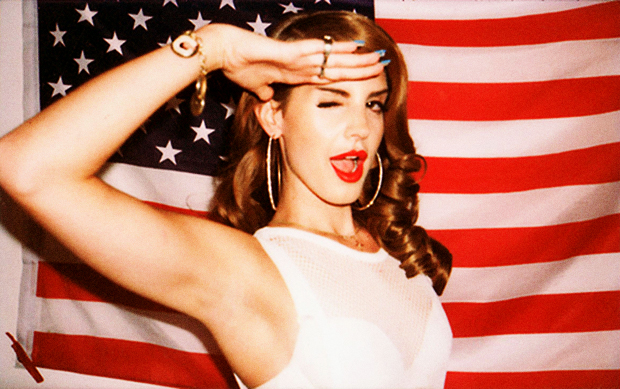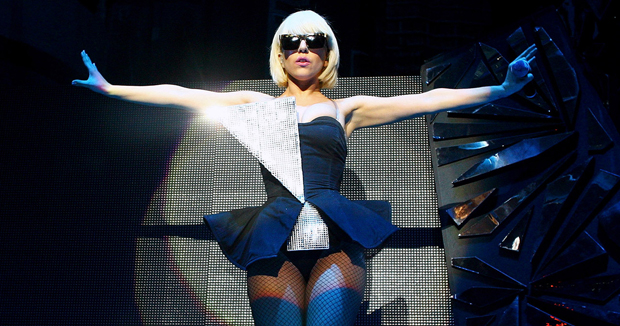
On November 11, 2011, Lana del Rey sings her “Video Games” song live on Amsterdam’s DDWD show. This counts as Lizzy Grant’s second live broadcasted performance as Lana del Rey, and it’s already loads better than her first.
Back on “Later With Jools Holland” in early October, the pale, strawberry blonde singer drones that same hit song into a microphone that seems curiously glued to her unpainted lips. Del Rey looks, in that first performance, nothing short of embarrassed of herself. Embarrassed not by her new identity, or her new face , but by the idea that the people watching are well aware of — or are even looking for — this “newness.” It’s as if she is trying to hide from the world, or pardon it of, the same surgically-enhanced pout that got people talking about her in the first place.
But chicks in the music business reinvent themselves all the time in order to win our hearts: just look at the intergalactic Lady Gaga. Look at her translucent skin and her large fishbowl eyes. Gaga was hatched from an egg on stage at the VMAs, and reigns from another hemisphere. That’s the way we like to think of her. When we are reminded that Lady Gaga’s real name is Stefani Germanotta we might feel uncomfortable, confused, or even lied to.
When I watch a forgettable talent show performance starring this Stefani girl on YouTube, I feel uneasy. This isn’t Lady Gaga. The dissociation between the “Pop Star” Lady Gaga and this “Stefani” character who used to play shows around the Lower East Side is so that these two are blatantly not the same person. We the public don’t care about Stefani, because Stefani is boring. We care about Gaga, the woman who does not have an age or bones or kidneys. This androgynous alien woman who lives under lightbulbs and survives off whiskey shots fascinates us, and we could give a shit (rather, we just aren’t interested) about who she was before.
So why is it that everyone is so mad that the “Video Games” singer changed her name from Lizzy Grant to Lana del Rey after her first album failed to garner any response? Who can blame Lizzy for removing her album off iTunes, redesigning her image (with help, of course), and morphing into this ghostly, pouty housewife thing that is supposed to represent the America we are nostalgic for?
Critics of del Rey argue that an artist who has been marketed as “indie” should be marketed as “authentic.” But first one needs to think about what it means to be marketed as indie. If a record company — Interscope, in del Rey’s instance — slaps that “indie artist” label on one of their artists, the market changes. The line between mainstream and indie is that change of market — that change in target audience.
But where there’s an audience, there’s manufacturing. And the way del Rey was portrayed the second time around just so happened to have popular appeal. Many audiences, not just the indie crowd, are nostalgic for this Old Hollywood, post-war America image del Rey represents — “the mainstream” included. So because del Rey has crossover appeal, is this a reason to label her as a “fake”?
Just something to think about: Kelly Clarkson, “American Idol’s” first winner, won America’s hearts by being the girl next door from Texas. The public chose Kelly Clarkson back in 2002 for three reasons: she was a sweetheart, she was all-American, and she could sing. “Idol” watchers weren’t rooting for “a superstar” (in fact, that first season of “American Idol” was actually titled “American Idol: The Search for a Superstar,” but the second part of the title was scrapped come season two).
Kelly Clarkson won that first season of “AI” because she was likable as a person before she was likable as a pop star. Nowadays, this tactic doesn’t work. Nowadays, Clarkson’s record company hides her image beneath synthy, club-heavy pop songs. Even our beloved Britney Spears has long since shed her down-to earth Louisiana girl image for one that is sleeker, sexier, more supernatural.
In terms of popular allure, Lana del Ray wavers somewhere between Clarkson and Gaga. She appeals to people who are nostalgic for the idea of that romantic, pre-fucked up America: fundamentalists, apathetic music bloggers, OWS protestors. On a personal level, we don’t know who del Rey is. Nor should we care. Because the image del Rey represents isn’t authentic at all. Nostalgia is inherently inauthentic: it’s the most ersatz concept that exists. We knew who Kelly Clarkson was before she became a pop star. She became a pop star because of who she was, and it didn’t work.
The retro-USA that Del Rey represents is an appeal that we find, much like Lady Gaga’s, both alien and fascinating. She reminds us of good times we don’t quite remember. And she sings about them too, in that elegiac voice that’s been described over and over again as haunting.
Del Rey’s haters are mad because they fell for the act. So give it up, everyone. There is nothing to be ashamed about. Manufactured or not, the spirit is there. And you love it! You support Lana del Rey.
—
Christina Drill is from Fair Lawn, New Jersey and currently writes and teaches in Panama City, Panama. She is Taylor Swift’s biggest fan. Follow her on Twitter! (@stidrill.)
